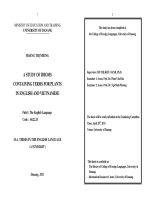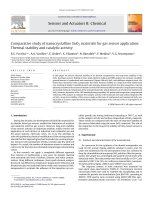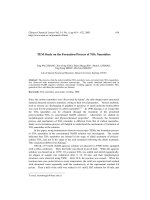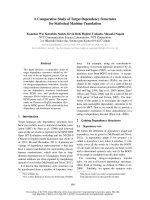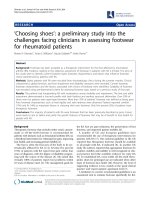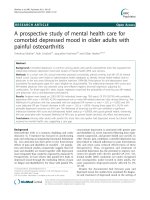A study of the polishing process of a turbine blade for automation
Bạn đang xem bản rút gọn của tài liệu. Xem và tải ngay bản đầy đủ của tài liệu tại đây (3.5 MB, 117 trang )
A Study Of The Polishing Process Of A Turbine Blade For
Automation
MARLON MARQUEZ MUSNGI
NATIONAL UNIVERSITY OF SINGAPORE
2006
A Study Of The Polishing Process Of A Turbine Blade For
Automation
Marlon Marquez Musngi
(BS in Manufacturing Engineering and Management)
A THESIS SUBMITTED
FOR THE DEGREE OF MASTER OF ENGINEERING
DEPARTMENT OF MECHANICAL ENGINEERING
NATIONAL UNIVERSITY OF SINGAPORE
2006
i
ACKNOWLEDGEMENTS
I would like to extend my sincerest gratitude to the following people who have
helped me in some way to make this work possible:
First and foremost, to my supervisors, Prof. Marcelo Ang and Prof. Teo Chee
Leong, for their incessant guidance, patience, encouragement and supervision all the
way through the research work,
To AUN/Seed Net, for the scholarship award,
To all my colleagues in the lab and in the MEM Department of DLSU Manila
for sharing their wild, wacky but nevertheless useful ideas,
To my family for providing me with their never-ending support
encouragement and prayers,
To my late father for pushing me to do my best and for believing in me,
And above all, to the Lord Jesus Christ, who has never failed to bring me
countless blessings …
ii
TABLE OF CONTENTS
Acknowledgments . . . . . . . . . . . . . . . . . . . . . . . . . . . . . . . . . . . . . . . . . . i
Contents . . . . . . . . . . . . . . . . . . . . . . . . . . . . . . . . . . . . . . . . . . . . . . . . . ii
Summary . . . . . . . . . . . . . . . . . . . . . . . . . . . . . . . . . . . . . . . . . . . . . . . . . v
List of Figures . . . . . . . . . . . . . . . . . . . . . . . . . . . . . . . . . . . . . . . . . . . vii
Chapter 1 Introduction . . . . . . . . . . . . . . . . . . . . . . . . . . . . . . . . . . . . 1
Section 1.1 Overview . . . . . . . . . . . . . . . . . . . . . . . . . . . . . . . . . . . . . . . . . . . 1
Section 1.2 Related Works . . . . . . . . . . . . . . . . . . . . . . . . . . . . . . . . . . . . . . 2
Section 1.3 Main Objectives . . . . . . . . . . . . . . . . . . . . . . . . . . . . . . . . . . . . . 3
Section 1.4 Potential Applications/Exploitations . . . . . . . . . . . . . . . . . . . . . 3
Section 1.5 Thesis Outline . . . . . . . . . . . . . . . . . . . . . . . . . . . . . . . . . . . . . . . 3
Chapter 2 Design of the Experimental Study . . . . . . . . . . . . . . . . . . . 6
Section 2.1 Overall description . . . . . . . . . . . . . . . . . . . . . . . . . . . . . . . . . . . 6
Section 2.2 The Turbine Blade . . . . . . . . . . . . . . . . . . . . . . . . . . . . . . . . . . . 8
Section 2.3 The Hardware . . . . . . . . . . . . . . . . . . . . . . . . . . . . . . . . . . . . . . 10
Section 2.3.1 The Polisher . . . . . . . . . . . . . . . . . . . . . . . . . . . . . . . . 10
Section 2.3.2 The JR3 Force Torque Sensor . . . . . . . . . . . . . . . . . 11
Section 2.3.3 The Polaris . . . . . . . . . . . . . . . . . . . . . . . . . . . . . . . . . 12
Section 2.3.4 The Host Computer . . . . . . . . . . . . . . . . . . . . . . . . . . 13
Section 2.4 The Software . . . . . . . . . . . . . . . . . . . . . . . . . . . . . . . . . . . . . . . 13
Section 2.4.1 The Main MFC Application . . . . . . . . . . . . . . . . . . . 13
iii
Section 2.4.2 The Main RTSS Application . . . . . . . . . . . . . . . . . . . 14
Chapter 3 Force Sensing . . . . . . . . . . . . . . . . . . . . . . . . . . . . . . . . . . . 16
Section 3.1 Initial Ideas . . . . . . . . . . . . . . . . . . . . . . . . . . . . . . . . . . . . . . . . 16
Section 3.1.1 Attaching sensor to the fixture to hold workpiece. . 17
Section 3.1.2 Attaching sensor to the bottom of the polisher . . . . 17
Section 3.2 Current Setup . . . . . . . . . . . . . . . . . . . . . . . . . . . . . . . . . . . . . . 18
Section 3.3 Software Codes . . . . . . . . . . . . . . . . . . . . . . . . . . . . . . . . . . . . . 19
Section 3.4 Data Gathered . . . . . . . . . . . . . . . . . . . . . . . . . . . . . . . . . . . . . . 20
Section 3.5 Need for Filtering . . . . . . . . . . . . . . . . . . . . . . . . . . . . . . . . . . . 21
Section 3.5.1 Getting the Frequency of the desired data . . . . . . . 21
Section 3.5.2 Designing the filter . . . . . . . . . . . . . . . . . . . . . . . . . . 22
Section 3.5.3 Results from filter . . . . . . . . . . . . . . . . . . . . . . . . . . . 23
Chapter 4 Motion Capture . . . . . . . . . . . . . . . . . . . . . . . . . . . . . . . . . 25
Section 4.1 Initial Ideas . . . . . . . . . . . . . . . . . . . . . . . . . . . . . . . . . . . . . . . . 25
Section 4.1.1 Using Laser Tracking System . . . . . . . . . . . . . . . . . . 26
Section 4.1.2 Using Machine Vision . . . . . . . . . . . . . . . . . . . . . . . . 26
Section 4.1.3 Using Phantom Desktop . . . . . . . . . . . . . . . . . . . . . . 27
Section 4.2 Current Setup . . . . . . . . . . . . . . . . . . . . . . . . . . . . . . . . . . . . . . 28
Section 4.3 Software Codes . . . . . . . . . . . . . . . . . . . . . . . . . . . . . . . . . . . . . 29
Section 4.4 Data Gathered . . . . . . . . . . . . . . . . . . . . . . . . . . . . . . . . . . . . . . 30
Chapter 5 Data Analysis . . . . . . . . . . . . . . . . . . . . . . . . . . . . . . . . . . . 31
Section 5.1 Data Transformation . . . . . . . . . . . . . . . . . . . . . . . . . . . . . . . . 31
Section 5.1.1 Orientation Data . . . . . . . . . . . . . . . . . . . . . . . . . . . . 33
Section 5.1.2 Position Data . . . . . . . . . . . . . . . . . . . . . . . . . . . . . . . 34
Section 5.1.3 Force Data . . . . . . . . . . . . . . . . . . . . . . . . . . . . . . . . . 35
iv
Section 5.1.4 Moment Data . . . . . . . . . . . . . . . . . . . . . . . . . . . . . . . 36
Section 5.2 Analysis of the Need of Force and Motion Control . . . . . . . . 36
Chapter 6 Recommendations for Compliant Motion Required for
Poloshing. . . . . . . . . . . . . . . . . . . . . . . . . . . . . . . . . . . . . . . . . . . . . . . . 39
Section 6.1 Amount of Force and Motion Needed . . . . . . . . . . . . . . . . . . 39
Section 6.2 When to Use Force and Motion Control . . . . . . . . . . . . . . . . 40
Chapter 7 Conclusion . . . . . . . . . . . . . . . . . . . . . . . . . . . . . . . . . . . . . 43
References . . . . . . . . . . . . . . . . . . . . . . . . . . . . . . . . . . . . . . . . . . . . . . 45
Appendix A . . . . . . . . . . . . . . . . . . . . . . . . . . . . . . . . . . . . . . . . . . . . . . 49
Appendix B . . . . . . . . . . . . . . . . . . . . . . . . . . . . . . . . . . . . . . . . . . . . . . 54
Appendix C . . . . . . . . . . . . . . . . . . . . . . . . . . . . . . . . . . . . . . . . . . . . . . 81
List
v
SUMMARY
With Airfoil Technologies Singapore (ATS) as partner, a plan to develop an
automated robotic polishing system using motion and force control is proposed. Aside
from technological and research advancements to be gained especially in the field
imitating human motions, the system would be able to perform the polishing job more
consistently resulting in better accuracy and at a faster rate.
In this research, the parameters involved in doing the polishing process are
investigated. Experiments are done to study the motion and forces required to do the
task of polishing turbine blades. The data gathered from these experimentations
are then analyzed to come up with the independent parameters a robot would need to
accomplish the task using motion and force control with respect to the end-effector.
The polisher used is a 4” belt and 6” disc sander. It is driven by an induction
motor running at 220V and giving out 1/3 Horsepower. The upper part of the polisher
was modified in order to accommodate the positioning of the force-torque sensor.
A 6-dof JR3 force-torque sensor is used and is attached to the polisher to
gather the force information of the polishing process. It is attached near the roller
where the belt revolves on. It is placed in a position where all the forces from the
polishing process can be captured with the minimum noise and obstruction.
vi
Motion of the workpiece is captured using a device called the Polaris. Using a
small rod fixture to connect the workpiece and the Polaris tool marker, position and
orientation are recorded through infrared light-emitting diodes fed back by the tool
marker to the Polaris Position Sensor. The fixture is designed in such a way that it
gives minimum or no disturbance at all to the worker while doing the polishing
process.
The data for both force and motion are gathered while a worker from ATS
performs the actual polishing process. This information from the sensors is sent to a
computer at a constant sampling rate of 10 Hz in real time. The analyses of these data
are then used to identify 6 independent force and motion parameters needed by a
robot to perform the task.
vii
LIST OF FIGURES
Figure 2.1 Overall description of setup with connections with location of reference
frames
Figure 2.2 The Turbine Blade
Figure 2.3 Turbine blade connected to the designed fixture
Figure 2.4 The turbine blade connected to the designed fixture held by the hand
Figure 2.5 The polisher with the modified part to accommodate the JR3 FT sensor
Figure 2.6 The main dialog window of the software
Figure 3.1 Graph of the freq. power distribution of data with polish and data w/o polish
Figure 3.2 Design of the 15
th
Order Butterworth filter with cutoff frequency at 0.5 Hz
Figure 3.3 Graph of the filtered and unfiltered FT Data
Figure 4.1 The Polaris active tool marker attached to the designed fixture
Figure 5.1 Reference frames of different reference points
Figure 5.2 Location of points A& B and their orientation
Figure 5.3 Graph of FT and POSE data (Trial 1)
Figure 5.4
Graph of FT and POSE data (Trial 2)
Figure 5.5
Graph of FT and POSE data (Trial 3)
Figure 6.1 Force and motion frequency (Trial 1)
Figure 6.2 Force and motion frequency (Trial 2)
Figure 6.2 Force and motion frequency (Trial 2)
1
CHAPTER 1 INTRODUCTION
The aim of this project is to identify independent parameters needed by a robot
in order to imitate a human performing a polishing of a turbine blade. This chapter
gives an introduction about the current polishing processes and systems. Section 1.1
gives the background and overview of how the topic was conceptualized. Some
related works and other thesis contributions are discussed in Section 1.2. Main
objectives are listed in Section 1.3. Section 1.4 provides the scope and limitations
while Section 1.5 presents the potential applications/exploitation of the research
project. An outline of the whole thesis is also provided in Section 1.6.
Section 1.1 Overview
Interaction between the robot’s end-effector and the environment determines
how good a robot can accomplish its task. No matter how good a robot moves with
respect to its base, it is still the motion and the force of the end-effector that matters
given a specific task. Therefore both motion and force control is needed for a robot to
perform well. One of the most challenging tasks for robotic applications is polishing
a surface with unknown geometry, specifically, the task of polishing turbine blades.
Currently, the polishing is done using skilled operators who are able to feel the
required forces and perform the appropriate motions to accomplish polishing. The
operator holds and guides a workpiece under a stationary grinder. Given the proper
training and practice, a worker would know how much force to apply and what
2
motions are required so that the workpiece is properly ground and polished. However,
training and practice could take too much time. They develop the skills through years
of experience. Such skilled operators are hard to come by and new operators have to
be trained and they learn and improve themselves through experience. We believe an
automated system would be able to perform the polishing job more consistently
resulting in better accuracy and at a faster rate.
Section 1.2 Related Works
In 1987, it was Dr. Oussama Khatib who first formulated the operational space
formulation, which is a unified approach for motion and force control of robot
manipulators. Since then, this new method of controlling robots, wherein the task is
described in terms of motion and forces in “operational space”, or the space where the
workpiece is in contact with the polishing tool, has been used by many other
researchers. One of them, Dr. Marcelo H. Ang Jr., together with Rodrigo Jamisola,
Denny Oetomo, Tao Ming Lim and Ser Yong Lim, implemented the operational space
formulation to aircraft canopy polishing in 2002.
In 1999, XQ Chen, ZM Gong, H Huang, L Zhou, SS Ge, Q Zhu, and LC
Woon developed an automated 3D Robotic Polishing System for Repairing Turbine
Airfoils. This system first checks on the profile of the turbine then uses an Adaptive
Robot Path Planner to generate the robot blending path and programs.
3
Section 1.3 Main Objectives
• Evaluate the feasibility of using motion and force control in automating the
polishing process
• Gather general motion and force information involved in polishing a turbine
blade
• Identify the independent parameters from which all the motion and force
information is dependent on
• Analyze and generalize a pattern for the independent parameters in doing the
polishing process
• Prepare the foundations for the development of actual system.
Section 1.4 Potential Applications/Exploitation
The developed system will be directly applicable to Airfoil Technologies
Singapore since this is one of the tasks their workers do everyday. They do polishing
of these turbine blades for aircraft repair. Aside from the fact that this will be a big
step in the advancement of robotic machining, upon verification of feasibility, this
could be the foundation for future polishing machine that can be commercialized and
marketed worldwide.
Section 1.5 Thesis Outline
This thesis is divided into 6 chapters.
4
Chapter 2 is on the Experimental Setup. In this chapter, the description of the
various hardware and software used is given in detail. The connection and
coordination of the different hardware to each other and to the software is also
discussed here.
Chapter 3 talks about the force sensing. This chapter basically discusses how
the force/torque information was gathered. The different setups that were thought of
and considered are described here as well. There is also a part in this chapter that
discusses the software code used to communicate with the sensor.
Chapter 4 discusses how the motion capture was done. All the ideas that were
deliberated on and tried are given in this chapter. Same as in chapter 3, some
software codes used to communicate with the hardware are also described here.
Chapter 5 is on Data Analysis. This is the part where the data from force
sensing and motion capture is presented, analyzed and put together. Filtration of
noise, vibration and other unnecessary data are discussed here. The relationship
between each data parameter is observed. This is where all the data is summarized
into independent parameters
Chapter 6 concludes the thesis and makes recommendation for further studies.
5
Competitive Advantage
It should be notable that people, who have actually developed and used this
new method of control and also have experience and knowledge in polishing
automation, are involved in this project. Also, add to this that Airfoil Technologies
Singapore, which does these polishings, is also a partner in doing the project.
Unlike other robotic polishing system developed by other researchers like the
Polishing Robot with Human Friendly Joystick Teaching System developed by
Fusaomi Nagata and Keigo Watanabe in 2000, the proposed system is fully automatic
such that the user would just be “overseeing” the task using a robot-man interface.
Also, in the proposed project, the robot manipulator would be pushing the workpiece
against a stationary belt grinder as apposed to usual polishing systems like the aircraft
canopy polishing system above where the robot manipulator pushes the grinder
against the canopy surface.
In 1999, XQ Chen, ZM Gong, H Huang, L Zhou, SS Ge, Q Zhu, and LC
Woon developed an automated 3D Robotic Polishing System for Repairing Turbine
Airfoils. This system is different from the proposed system in such a way that it first
checks on the profile of the turbine and then uses an Adaptive Robot Path Planner to
generate the robot blending path and programs while the latter uses force feedback to
obtain force control.
6
CHAPTER 2 DESIGN OF THE EXPERIMENTAL STUDY
The main concern for the setup is to be able to gather force and motion of the
polishing process. This means motion of the blade and the force it applies has to be
recorded simultaneously while doing the polishing with the least disturbance to the
polisher operator.
This chapter discusses the setup of the hardware and software used in the
experiment. Section 2.1 is about the overall description of the setup. It illustrates the
setup for experimentation and how the devices are connected with each other. Section
2.2 describes the blade to be polished and the fixtures designed to hold it. Section 2.3
deals with the hardware setup while Section 2.4 provides information about the
software setup.
Section 2.1 Overall Description
The experiment is setup in such a way that all the devices needed must be
working together with one another and thus connected with each other.
The computer is where the user or the host communicates with the system.
The software developed is the interface between the user and the computer. The
computer is connected to the two sensors for it to send and receive data. The JR3 FT
Sensor is connected to the computer through the card receiver which is inserted into
7
the ISA slot of the motherboard. The Polaris connects to the computer via the RS-232
serial port.
The JR3 FT sensor is attached to the polisher as described in Section 2.3.1.
This way, when the workpiece comes in contact with the polisher, the JR3 FT sensor
would be able to sense it.
The workpiece, held by the fixture described in Section 2.2, is connected to
the Active tool marker of the Polaris. This tool marker which is connected to the
Polaris Tool Interface Unit (TIU), will be the one to emit infra-red light that would be
received by the Polaris Position Sensor. Figure 2.1 shows these connections.
computer
Polaris TIU
Top view of Polaris position
sensor
1000 mm
To serial port
JR3 FT sensor
To card receiver
To TIU
Workpiece with fixture
and active tool marker
To active tool marker
Top view of polisher
Figure 2.1 Overall description of setup with connections with location of reference frames
8
Section 2.2 The Turbine Blade
The turbine blade came from Airfoil Technologies Singapore, the company
which actually does the polishing of these blades through the help of Mr. Lee Ngan
Ming. The size is around 10mm x 12 mm x 30 mm. It is uniquely shaped in such a
way that the upper part is slightly curved and this curve is further twisted slightly.
Figure 2.2 shows two blades, one without the weld, and the other with some polishing
done on the weld already.
Figure 2.2 The Turbine Blade
Since the objective of the experiment is to be able to gather force and motion
data while polishing with minimal disturbance to the worker, a fixture is designed to
hold the workpiece (blade) and to connect it to the other hardware used for data
gathering. In designing the fixture, the major consideration is for the worker to be to
hold the workpiece almost the same way with or without the fixture.
9
Since the worker holds the workpiece mainly with his or her 2 fingers (thumb
and pointing finger) and with the fist in a some sort of semi-clenched position, it was
decided to design some sort of a rod that would go through the inside of the semi-
clenched fist to connect to the desired measuring device. To secure the workpiece in
place, a sort of cap with a slit on its cover was also designed. Figure 2.3 shows the
designed fixture with a blade with weld attached to it. Figure 2.4 shows how this
fixture is held by the hand.
Figure 2.3 Turbine blade connected to the designed fixture
10
Figure 2.4 The turbine blade connected to the designed fixture held by the hand
Section 2.3 The Hardware
There are a total of four (4) machines/hardware used in the experiment, each
connected to the other. This section describes the function of each part.
Section 2.3.1 The Polisher
The polisher used is a 4” belt and 6” disc sander. It is driven by an
induction motor running at 220V and giving out 1/3 Horsepower. The upper
part of the polisher was modified in order to accommodate the positioning of
the force-torque sensor. Figure 2.5 Shows the polisher with the modified part
to accommodate the force torque sensor.
11
Figure 2.5 The polisher with the modified part to accommodate the JR3 FT sensor
Section 2.3.2 The JR3 Force-Torque sensor
The JR3 Force Torque sensor provides 6 degree-of freedom force and
torque data at very high bandwidths. Employing an Analog Devices ADSP-
21xx family digital signal processing chip, the JR3 system can provide
decoupled and digitally filtered data at 8 kHz per channel. It is connected to
the JR3 DSP based bus compatible receiver of the ISA (IBM-AT) bus version.
The board, consisting of the Digital Signal Processor, also has shared dual-
ported address space of 16k 2 byte words to which both the host and the DSP
can read and write. Use of the dual ported RAM allows the host to read data
from the DSP with very little overhead. It also allows the host to reconfigure
the DSP on the fly, by writing configuration commands to the RAM.
12
The ISA (IBM-AT) bus receiver card, which plugs into a 16 bit slot on
the ISA bus, uses both the 62 pin and the 36 pin connector. The receiver
occupies 4 consecutive I/O addresses in the range of 000 to 3FF hexadecimal.
The base address is selected by dip switches on the card. The two lower I/O
addresses form a 16 bit address register, the two upper addresses form a 16 bit
data register. The address to be read or written (in the dual port shared address
space) is written to the address register; the data is then read from or written to
the data register.
Section 2.3.3 The Polaris
The Polaris System determines real-time position and orientation by
measuring the 3D positions of markers affixed to both wired and wireless
tools. The system used in this experiment uses a Position Sensor that detects
retro-reflective optical markers, calculates the 3D/6D position of a tool; and
reports the result via a serial interface to the host computer. The tool the
sensor detects consists of 4 active markers mounted on a planar rigid body.
The Polaris system tracks wired active tools with infrared light-
emitting diodes. Active markers emit infrared light which is received by the
position sensor. The position sensor receives light from marker reflections
and marker emissions, respectively. The Polaris system triangulates the 3D
position and orientation of a tool to provide 6 Degrees of Freedom.
13
The 3D position of the target point is calculated from the measured
position and the orientation of the rigid body is defined by the markers.
Section 2.3.4 The Host Computer
The host computer used in the setup is an Intel Pentium II 400MHz
processor with 320MB RAM. It has at least one ISA slot for the JR3 receiver.
It also runs under Microsoft Windows 2000 with RTX extension.
Section 2.4 The Software
The main software used in this project is Microsoft Visual C++. It runs under
Microsoft Windows 2000 with RTX extension. The software is actually divided into
2 parts, the Main MFC Dialog and the Main RTSS application.
Section 2.4.1 The Main MFC Dialog
The Main MFC Dialog is the user interface part of the software. This
is the part where the hardware is initialized. This is also where the shared
memory (also to be used by the RTSS Application) and real time timer is
created.
The dialog window is divided into 4 parts, the Control part, where the
buttons are located for initializing and starting the data gathering procedure;
the Force and Torque part, where the force and torque readings are displayed
and graphed; the POSE part, where position and orientation readings are
14
displayed; and the status part, where the status of the whole system is
indicated. Figure 2.6 shows the dialog window for this.
Figure 2.6 The main dialog window of the software
Section 2.4.2 The Main RTSS Application
The Main RTSS application is where the actual data gathering in real
time takes place. Windows alone will not be able to do a specific task in real
time, much more if some graphics are done and some other multitasking jobs.
If this is the case, the sampling time would somehow be dependent on the
capability of the processor. Once the processor has several tasks to
accomplish, most likely, the sampling time would not be as desired and would
not be consistent.
This application runs independently but shares memory with the Main
MFC. Using the shared memory, the RTSS Application stores the data
15
gathered for which the MAIN MFC can access and download to show and
graph the data in the dialog window.
16
CHAPTER 3 FORCE SENSING
Knowing what kinds of forces are involved in the polishing process helps in
achieving better and faster polishing results since the exact amount and direction of
the force can be applied. This minimizes or even eliminates unnecessary work plus
excess cutting or polishing is avoided.
This chapter discusses everything about force sensing that was done in the
experiment. Section 3.1 describes the initial ideas that were thought of on where to
put the sensor. It also discusses the pros and cons of each idea. Section 3.2 shows the
accepted setup for force sensing. Some software codes are given in Section 3.3, and
the data gathered from force sensing is explained in section 3.4. Since noise is
inevitable in this situation, Section 3.5 gives the details why filtering would be
needed.
Section 3.1 Initial Ideas
Having already a JR3 FT sensor at hand, the problem was how to get the
needed data. Several ideas were thought of regarding where to attach the sensor in
order for us to get accurate data. This section presents some of these significant ideas.
